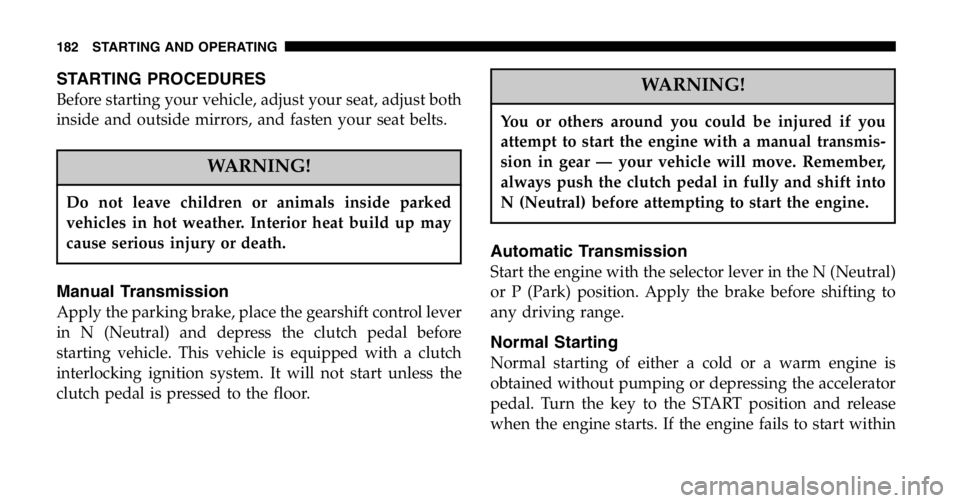airbag JEEP WRANGLER 2006 Owners Manual
[x] Cancel search | Manufacturer: JEEP, Model Year: 2006, Model line: WRANGLER, Model: JEEP WRANGLER 2006Pages: 1472, PDF Size: 12.64 MB
Page 182 of 1472

Do not put anything on or around the front airbag
covers or attempt to manually open them. You may
damage the airbags and you could be injured be-
cause the airbags are no longer functional. These
protective covers for the airbag cushions are de-
signed to open only when the airbags are inflating.
Front Airbag Components
THINGS TO KNOW BEFORE STARTING YOUR VEHICLE 27
2
Page 186 of 1472

Ignoring the “Airbag Warning Light” in your instru-
ment panel could mean you won’t have the airbags
to protect you in a collision. If the light does not
come on, stays on after you start the vehicle, or if it
comes on as you drive, have the airbag system
checked right away.
2
Page 188 of 1472

Deployed airbags cannot protect you in another
collision. Have the airbags replaced by an autho-
rized dealer as soon as possible.
Maintaining Your Airbag System
WARNING!
2
Page 190 of 1472

In a collision, an unrestrained child, even a tiny
baby, can become a missile inside the vehicle. The
force required to hold even an infant on your lap can
become so great that you could not hold the child, no
matter how strong you are. The child and others
could be badly injured. Any child riding in your
vehicle should be in a proper restraint for the child’s
size.
Infants and Small Children
There are different sizes and types of restraints for
children from newborn size to the child almost large
enough for an adult safety belt. Always check the child
seat owner’s manual to ensure that you have the right
seat for your child. Use the restraint that is correct for
your child.
•The rearward-facing infant carrier is for babies weigh-
ing up to about 20 lbs (9 kg), and one year old or more.
The infant restraint must NEVERbe used in the front
seat of a vehicle with a front passenger airbag unless
the airbag is turned off. An airbag deployment could
cause severe injury or death to infants in this position.
The infant carrier is held in the vehicle by the lap belt,
lap/shoulder belt, or the LATCH child restraint an-
chorage system.
•Children under one year of age should continue to ride
in a rear-facing infant seat, even if they weigh more
than 20 lbs (9 kg). A “convertible” child seat, one that
is designed to be used either rearward-facing or
forward-facing, should be used for children who are
too heavy for the infant carrier, but who are too young
to face forward in the vehicle.
•The forward-facing child seat is for children from
about 20–40 lbs (9–18 kg), and more than one year old.
THINGS TO KNOW BEFORE STARTING YOUR VEHICLE 35
2
Page 540 of 1472

Do not put anything on or around the front airbag
covers or attempt to manually open them. You may
damage the airbags and you could be injured be-
cause the airbags are no longer functional. These
protective covers for the airbag cushions are de-
signed to open only when the airbags are inflating.
Front Airbag Components
THINGS TO KNOW BEFORE STARTING YOUR VEHICLE 27
2
Page 898 of 1472

Do not put anything on or around the front airbag
covers or attempt to manually open them. You may
damage the airbags and you could be injured be-
cause the airbags are no longer functional. These
protective covers for the airbag cushions are de-
signed to open only when the airbags are inflating.
Front Airbag Components
THINGS TO KNOW BEFORE STARTING YOUR VEHICLE 27
2
Page 902 of 1472

Ignoring the “Airbag Warning Light” in your instru-
ment panel could mean you won’t have the airbags
to protect you in a collision. If the light does not
come on, stays on after you start the vehicle, or if it
comes on as you drive, have the airbag system
checked right away.
2
Page 904 of 1472

Deployed airbags cannot protect you in another
collision. Have the airbags replaced by an autho-
rized dealer as soon as possible.
Maintaining Your Airbag System
WARNING!
2
Page 906 of 1472

In a collision, an unrestrained child, even a tiny
baby, can become a missile inside the vehicle. The
force required to hold even an infant on your lap can
become so great that you could not hold the child, no
matter how strong you are. The child and others
could be badly injured. Any child riding in your
vehicle should be in a proper restraint for the child’s
size.
Infants and Small Children
There are different sizes and types of restraints for
children from newborn size to the child almost large
enough for an adult safety belt. Always check the child
seat owner’s manual to ensure that you have the right
seat for your child. Use the restraint that is correct for
your child.
•The rearward-facing infant carrier is for babies weigh-
ing up to about 20 lbs (9 kg), and one year old or more.
The infant restraint must NEVERbe used in the front
seat of a vehicle with a front passenger airbag unless
the airbag is turned off. An airbag deployment could
cause severe injury or death to infants in this position.
The infant carrier is held in the vehicle by the lap belt,
lap/shoulder belt, or the LATCH child restraint an-
chorage system.
•Children under one year of age should continue to ride
in a rear-facing infant seat, even if they weigh more
than 20 lbs (9 kg). A “convertible” child seat, one that
is designed to be used either rearward-facing or
forward-facing, should be used for children who are
too heavy for the infant carrier, but who are too young
to face forward in the vehicle.
•The forward-facing child seat is for children from
about 20–40 lbs (9–18 kg), and more than one year old.
THINGS TO KNOW BEFORE STARTING YOUR VEHICLE 35
2
Page 1027 of 1472

Ignoring the “Airbag Warning Light” in your instru-
ment panel could mean you won’t have the airbags
to protect you in a collision. If the light does not
come on, stays on after you start the vehicle, or if it
comes on as you drive, have the airbag system
checked right away.
2